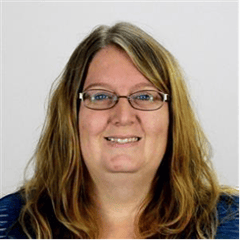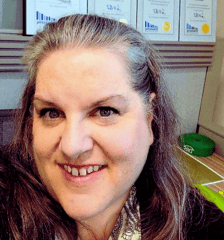Peer Intelligence | Winter 2023
Note of PINterest
By Yvette van Velsen
The Peer Intelligence Network (PIN) wouldn’t be successful without contributions from our clients. Let’s meet our two top contributors Shannon Warner and Valerie Stone.

Shannon Warner

Valerie Stone
Shannon has been with Ohio PERS for 24 years. In her current role as a Process Manager, her main focus is working with business and IT to streamline processes and create efficiencies. In the span of 5 years, she and her peers have redesigned and modernized all of Ohio PERS pension processes resulting in the implementation of over 300 business process recommendations. As a result of the redesigns, their processing is completed almost same-day while the capacity required to complete the respective processes has been greatly reduced. This has allowed OPERS to be successful in meeting demands for baby boomers and several of OPERS’ tenured processors retiring.
Valerie has been at Washington State Department of Retirement Systems for 17 years, and she loves what she does. She is in the Supportive Services unit of the Retirement Services Division, which is their customer-facing division. She’s the team leader for their Resource Team and Central Reception Unit. The Resource Team administers the internal online manual as well as team member access to the secure online account application for members. The Central Reception Unit (CRU) is a team that provides frontline customer service in the office and over the phone. Her work is geared toward providing information and resources to her fellow team members so that they can best assist customers.
CEM: How did you get involved in the PIN?
SW: OPERS has participated with CEM for over 20 years and has been involved in the PIN for just as many. As individuals’ roles have changed within our organization, the CEM relationship has transitioned to my department. In the Process Manager role, I have a wide depth of knowledge of OPERS’ processes and policies. As a result, I have taken on the responsibility for the CEM annual survey along with participating on the PIN.
VS: I started by working closely with our Budget and Performance Management Director, Mark Feldhausen, on fielding most of the PIN questions that were related to my division (Retirement Services). Since most of the PIN questions are related to functions within the Retirement Services Division, I ended up looking at all of the questions that were posted and obtaining responses from other divisions of the agency when needed.
CEM: How is the PIN used in your organization?
VS: We use the PIN to gather input from our peers whenever we are considering changing or implementing a new process. It’s always helpful to know what other systems have learned before we try it out, including what to do and, especially, what NOT to do!
SW: At OPERS, the PIN is used to ask questions/experiences from other pension systems, and to determine how our peers are handling similar processing or organizational issues/concerns. A benefit in the public pension industry is that we are truly peers and not competing against one another. As we are considering various options at OPERS, we find it very useful to collaborate on PIN topics with other pension systems to learn about their experiences and things we could consider.
CEM: What do you like the most about the PIN?
SW: The PIN is a great tool to collaborate with peers and learn from one another. Typically, many discussion posts are similar topics that are arising at OPERS. The discussions on the PIN provide opportunities to see how our peers have handled similar situations that we are experiencing. It also shows us another perspective and helps us mitigate potential issues or risks.
VS: I like the social aspect, the camaraderie, and the feeling of being part of a larger “team”. Even though we are in different states or countries, it feels like we are all in this pension thing together and wishing each other well. We are not competing with each other but sharing information in order for us all to do our best for our customers.
CEM: Any other advantages?
VS: It’s helpful to discuss issues with other organizations that are doing the same thing. Although we are a state agency, it’s not nearly as valuable to seek input from other agencies in our state nor even the private sector. You can get some insights that way, but it’s more work – like comparing apples to oranges.
SW: In responding to questions posted on PIN, I have found myself learning more about my organization. The questions posted can span a range of topics that I may not know much about and could require additional research or reaching out to individuals I don’t typically interact with.
CEM: Any advice for other systems to get the most out of the PIN?
SW: The PIN contains a wealth of knowledge and history on how the public pension systems have evolved. I would greatly suggest that as systems contemplate new ideas to post questions on the PIN because most likely someone has gone through similar discussions/experiences and could provide insight. Even if you do not have questions, it’s beneficial to read through the discussion topics as they may spur new ideas relevant to your respective system.
VS: Don’t be shy, ask whatever questions you need to get your information! The more specific the questions are, the easier they are to answer, so you will likely get more responses. Also respond to as many questions as you can, even if the answer is not applicable. That too is valuable information. And don’t forget to search the vast library of former questions and responses before you post; you may find that your questions were already asked and answered recently.
Also, Mark (from our team) couldn’t resist chiming in on this question as he was our initial point of contact on what used to be called “peer network questions.” His advice (request) would be for systems to respond to as many questions as they can, even if the answer is that it “does not apply because…” In setting the expectation that we will respond to all of the questions sent to DRS via the peer network or PIN, it may take a bit more work to develop some of the N/A responses but we feel it’s more valuable for another participant to get something from Washington State than no response at all. That way the peer that posted the question receives something from DRS and the ability to contact us if they think it could be of interest in their analysis. We may even obtain and provide information from one of our fellow state agencies (e.g. the State Investment Board, the Health Care Authority, the Office of the State Actuary, etc.) if the question deals with an aspect of public pension administration that is performed by a different entity in our state.
CEM: What you would like to see on the PIN?
VS: Just more activity, more use. If you’re like me, this is a small part of your job and sometimes it’s hard to keep up. But in the end, it’s very rewarding and worth taking the time to do.
SW: OPERS has benefited from the questions/responses posted on the PIN. It would be very advantageous for more systems to actively participate to provide broader perspectives.
CEM: What can be improved?
SW: Nothing right now. I think that the PIN is easy to understand and navigate.
VS: I would prefer that users post their questions and not post links to external surveys they have created. When I see a survey link, I assume that there are more questions than usual and that I will probably not be able to see the responses from the rest of the group. And the following is more of a request for peers to identify if they’ve submitted their PIN question through other channels. There have been instances in the past when we’ve had different individuals working on responding to the same question because it came into DRS through PIN as well as through P2F2 or NASRA.
Other than that, I think it’s working great!
CEM: Thank you both for participating in the interview and your contributions to the PIN.
If you would like to know more or receive access to the PIN, email me at yvette@cembenchmarking.com, contact your relationship manager, or contact us here.
If you are a client and would like to log in, click here
Peer Intelligence | Winter 2023
